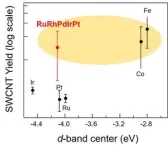When we communicate with other people face-to-face, we do so by maintaining a certain physical distance from each other. This space surrounding our body while interacting is called the interpersonal space (IPS), and maintaining adequate IPS is crucial for better communication.
Many studies have investigated the psychological and physiological changes that occur based on the presence of another person in the IPS during face-to-face interactions. These studies are based on the avoidance behaviour that we experience when a stranger invades our IPS, which manifests in the form of increased heart rate and discomfort. However, having a social relation with a person, such as with a friend or a spouse, can influence this behaviour. Moreover, most studies have only examined IPS in front of or behind a person, using tasks such as a stopping task, wherein a stranger approaches or retreats from the IPS. They have not determined the shape of IPS by considering different relative positions around a person.
Addressing this gap, a team of researchers from Japan, led by Assistant Professor Kae Mukai from the Faculty of Science and Engineering at Waseda University, investigated the effect of social relationships on the physiological and psychological responses to the presence of another person in the IPS. Dr. Mukai explains, “Considering a real-life situation in which acquaintances or friends are standing next to us, the threat level might be relatively low compared to when strangers are standing next to us. Given the evidence, that smaller IPSs may be formed with family and friends, psychological and physiological responses can differ. In this study, we uncovered these differences.” The team also included Dr. Tomoko Isomura from Nagoya University and Dr. Ryoji Onagawa and Professor Katsumi Watanabe from Waseda University. Their findings were published in the journal Scientific Reports on February 21, 2024.
The researchers used electrocardiogram (ECG) data to measure the changes in subjective discomfort, heart rate, and heart rate variability (HRV), which indicates parasympathetic activity or the “rest and digest” nervous response, of a person due to the presence of another person at various relative positions in the IPS. They measured these changes during two tasks. In the first task, participants were paired with their friends in a static standing task, where a person stood 30 cm away from the other, with both hands behind their back, within the IPS for a minute.
There were eight relative positions in all: F-see, L-see, R-see, and B-see, as well as F-seen, L-seen, R-seen, and baseline. In the first case, participants stood face-to-face with their friend and looked at the center of their eyes. In the next three cases, they looked at their friend’s left profile, right profile, and back, respectively, with their eyes fixed on the head. On the other hand, the participants stood with their eyes fixed on the fixation point 30 cm in front of them while being seen at their left profiles, right profiles, and backs by their friend in F-seen, L-seen, and R-seen conditions, respectively. Lastly, in the baseline condition, both persons were standing back-to-back, unable to see each other. In the second task, a cylindrical object with height same as that of the person was placed at different positions in the IPS.
The experiments revealed that the greatest discomfort, the greatest decrease in heart rate, and the greatest increase in HRV occurred in the F-see condition. The researchers attributed the decrease in heart rate and increase in parasympathetic activity to the presence of familiar people, as previous studies have shown that the presence of a friend or romantic partner activates parasympathetic activity. Moreover, they found that heart rate only decreased in relative positions F-see and R-see. Additionally, no changes were observed during the task with the object.
These findings are inconsistent with previous studies which report that sympathetic activity, or the “fight or flight” response, is activated when a stranger invades our personal space. “Our study suggests that social relationships between two people influence our physiological responses during social interactions,” says Dr. Mukai. “Our findings could help in the development of a society that makes life easier for a diverse range of people, by introducing appropriate communication methods that vary according to changes in responses to the presence of others.”
***
Reference
DOI: https://doi.org/10.1038/s41598-024-54439-5
Authors: Kae Mukai1,2, Tomoko Isomura3, Ryoji Onagawa1,2, and Katsumi Watanabe1
Affiliations
1Faculty of Science and Engineering, Waseda University, Japan
2Japan Society for the Promotion of Science, Japan
3Graduate School of Informatics, Nagoya University, Japan
About Waseda University
Located in the heart of Tokyo, Waseda University is a leading private research university that has long been dedicated to academic excellence, innovative research, and civic engagement at both the local and global levels since 1882. The University has produced many changemakers in its history, including nine prime ministers and many leaders in business, science and technology, literature, sports, and film. Waseda has strong collaborations with overseas research institutions and is committed to advancing cutting-edge research and developing leaders who can contribute to the resolution of complex, global social issues. The University has set a target of achieving a zero-carbon campus by 2032, in line with the Sustainable Development Goals (SDGs) adopted by the United Nations in 2015.
To learn more about Waseda University, visit https://www.waseda.jp/top/en
About Assistant Professor Kae Mukai
Kae Mukai is currently an Assistant Professor at the Faculty of Science and Engineering at Waseda Research Institute for Science and Engineering in Waseda University in Japan. He obtained his Ph.D. from the University of Tokyo in 2020. He is also a member of the Japan Society for the Promotion of Science. His research interests include humanities, social sciences, cognitive science, life sciences, and sports psychology.
END








